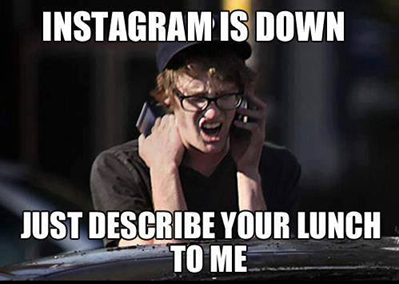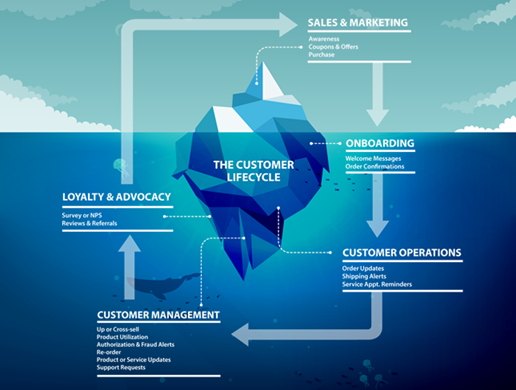Jonathan Morgan, CEO, OpenMarket – September 3, 2015
A highlight of my job is that I get to talk to customers and potential customers about the benefits of mobile engagement, and how it can be used to delight consumers or optimise internal business communications.
One of the most common questions I get asked is “which channel should I be using?” And in particular, “when is SMS the right channel to use?” As the channels available for organisations to communicate with their key constituents – employees, customers, fans, or supporters – are increasing all the time, this question is only getting more important every day.
A man has to use voice because the optimal channel for viewing lunch is not available.
Today we are seeing the rise of what’s being termed “opti-channel communication.” This means using the channel that’s optimum for each point in the customer journey. So, let’s have a look at what to use and when.
When SMS is Best
We’ll start with SMS, or text messaging. In simple terms, you want to be using SMS under the following conditions:
1. Time sensitivity – this is when you really want the message to reach the recipient and be read within a few minutes. Notice this is different than email, where you know when it’s been sent, but you can’t be sure when it will be read.
2. Immediacy of receipt – 95% of SMS is read within 3 minutes, so this means the message is being opened and read promptly – something you can’t be sure about with other communication channels.
3. Desired response – SMS is possibly the best way of guaranteeing a quick response; and by using call back technology, you can make this experience seamless for the user.
4. Global reach – every mobile handset can support SMS. In addition, SMS almost always works when you are roaming. The same cannot be said if you are relying on data roaming to be activated, which given the cost, not everyone willingly does.
I often hear concerns around the perceived cost of SMS, because some other channels are thought of as being free. In general, if you’re concerned that an SMS message isn’t free, and you want to keep your costs down, then consider how important this specific customer touch point really is. Is the customer really going to take notice, and is it worth cluttering their life with yet another message in a world full of competing noise? Is it enhancing the relationship or experience with your consumer, or in reality, is it diminishing it a little bit every time?
In my experience, there’s always some point in the customer journey when using SMS is best.
Companies can use SMS across the entire organisation and throughout the entire customer journey
Let‘s think through a few examples like buying an item online and abandoning a cart, which is the perfect opportunity to send an SMS offering assistance or a call back. Another scenario is sending a password that you want to arrive quickly and reliably. You can also use SMS to deliver a promotion or an offer to consumers before it expires. There are many use cases for SMS, however, if the message is not as urgent or perhaps more of an FYI, then email could be more suitable.
One example of how to get it wrong is when I recently bought a pizza online. A few minutes after completing my purchase, an email was sent letting me know the pizza had entered the oven. Now the only problem here is that I probably wouldn’t read my email on that account for a few days, after which the immediacy of that information is lost. If it’s a key service touch point with consumers, you always should be using SMS.
An example of how to get it right is when I recently made a credit card payment overseas. My bank, fearing my personal details had been stolen, used an SMS to query the transaction. I wanted the payment to go through, and it allowed me to call back the number on the SMS to confirm the transaction with the issuer. This was a fabulous customer experience and I can’t imagine how you would accomplish that same level of service with a push notification or an email.
Mobile Apps, Email, Social Media and More
Many people talk about messaging apps, and surely the new wave of apps are attractive. WhatsApp, WeChat, and LINE are very popular for communicating with friends and family, but the jury is still out on their effectiveness for enterprise customer engagement. Our own OpenMarket team of millennials verified they have used all of these free apps when they “just need to get a hold of the person.” There is no doubt that mobile apps are good for engaging with high-value, power users, but if you’re interested in interacting with all of your customers via mobile, then SMS is simply better due to its ubiquity.
Push Notifications are often perceived as a good alternative. They reach your handset immediately. But, if you look at any millennial’s phone, you’ll likely see a sea of notifications on their screen. Will your push message really get the attention it deserves? Will it cut through all of the noise? Does it work when your customers are travelling and that expensive roaming data is switched off? Push has its place, of course. Every morning, I wake up to news headlines that are conveniently waiting for me which saves me hours of searching through various news sites. But it’s really what it says on the tin – it’s just for notifying you of things you may be interested in.
That brings us to email. Email should be used when communicating basic information which is not time-sensitive. Use email for things that users need to reference some point in time – either now or way into the future. This includes successful signups, confirmations, reference codes, orders and receipts. Email shouldn’t be used for urgent actionable items. Zipstripe found that the average time for recipients to view an email message is as long as 6.4 hours.
As for social media channels, there are many platforms to consider. A recent Sales and Marketing study revealed that social media is one of the fastest growing channels that enterprise B2B buyers use to research products, solutions and vendors in 2015 compared to a year ago. LinkedIn and Twitter are often the most effective ones for engaging with B2B customers, with Facebook, Instagram and others as options for more informal dialogue. Of course, this can depend on your industry, region and demographics. To me, Instagram is for when you have a great photo to share, whilst Twitter seems to be a better option for a rant, or a debate at least! It facilitates conversations so well.
With opti-channel communication on the rise, now is the time to review how your organisation engages with its key constituents. Many times the age old maxim of “less is more” applies. If your messaging requires any of the four attributes listed above, then SMS is the right solution for you.




